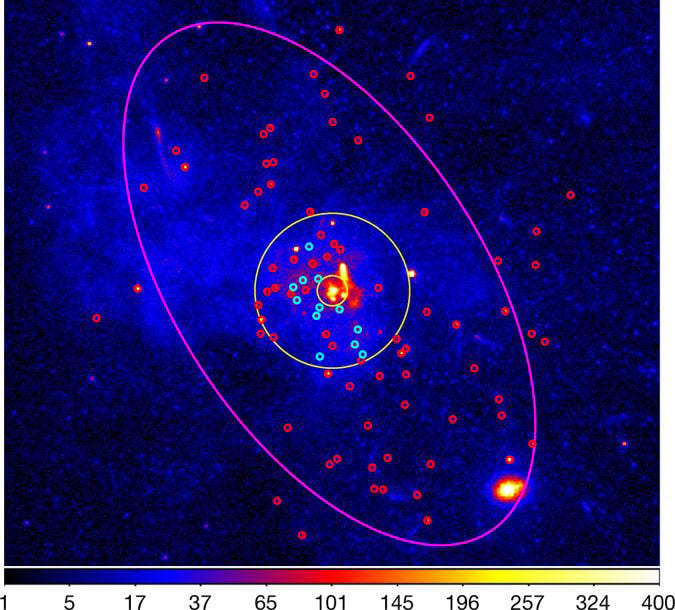
A Chandra image of the central tens of light-years of the Milky Way. Red and cyan circles are X-ray emitting sources with the latter being black hole binaries. Astronomers have concluded that these results are consistent with galaxy evolution models that predict tens of thousands of black holes have accumulated in the central region of the galaxy (the observations only see the brightest black holes in binary systems). NASA/Chandra
A binary star system is one that contains a pair of stars orbiting each other. A black hole X-ray binary is a binary system in which one of the stars is a black hole and the other is a normal star. When matter from the normal star accretes onto the black hole, charged particles are ejected that emit X-ray radiation, making identification of these objects possible. At the other extreme, the most massive known black holes, with millions or even billions of solar-mass, exist at the centers of most galaxies including our own, and one of the basic predictions of galaxy evolution is that the gravitational potency of a nuclear supermassive black hole should lead to a dense accumulation of black holes in its vicinity. The models predict that as many as twenty thousand black holes should have settled into the central few light-years of our Milky Way. (For a sense of how extreme this scenario is, consider that the closest star to our Sun, Proxima Centauri, is 4.2 light-years away.) Until now, however, no such density cusp of black holes has been detected.
The most straightforward way to detect a black hole is to find it in an X-ray binary system. Writing in last week’s issue of the journal, Nature, CfA astronomer Jaesub Hong and five colleagues used the Chandra X-ray Observatory archive to identify a dozen X-ray binaries in a density cusp within three light-years of the Galactic Center. Over the past twelve years, Chandra has observed the region for over 380 hours. The scientists analyzed X-ray images of the region between 0.65 and 12.4 light-years from the supermassive black hole (the innermost region had too many complicating sources). They found 415 X-ray point sources, and after carefully considering other possible origins for each one (novae, unusual stars, extragalactic background sources, among other possibilities) they conclude that these dozen are black hole X-ray binaries. The authors then consider the sensitivity limits, the expected abundance of single black holes relative to binaries, and other uncertainties to conclude that the observed number is in good agreement with general model expectations for black holes. They add, however, that alternative models of galaxy evolution cannot be entirely excluded. Some of the observed binaries could be the result of unique events, for example if a globular cluster and its black holes fell into the region.
Reference: “A Density Cusp of Quiescent X-Ray Binaries in the Central Parsec of the Galaxy” by Charles J. Hailey, Kaya Mori, Franz E. Bauer, Michael E. Berkowitz, Jaesub Hong and Benjamin J. Hord, 5 April 2018, Nature.
DOI: 10.1038/nature25029









In search of black holes and dark matter astrophysicists are relying on indirect observations. It would seem that the measurement of the event horizon of a black hole directly would be a direct evidence. However, by the nature of a horizon, any real measurement of the event horizon will be indirect. The Event Horizon Telescope will get picture of the silhouette of the Sgr A* which is due to optical effects of spacetime outside of the event horizon. The result will be determined by the simple quality of the resulting image that does not depend on the properties of the spacetime within the image. So, it will be also indirect and an existence of BH is a hypothesis.
https://www.academia.edu/12468184/Are_there_Black_Holes_and_Dark_Matter_in_the_Milky_Way